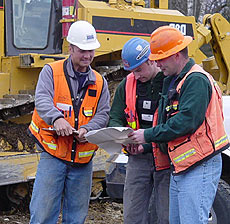Feature Article
There is a saying that goes like this: Drilling is not dangerous; it is potentially dangerous. There are many potential dangers faced by personnel working on and around drilling equipment. Personnel in this sense includes drillers, helpers, field sampling staff, site occupants, and the general public. One of the most substantial dangers to all of the above mentioned parties in a drilling project, are the risks associated with underground utilities. Utility issues are so important to the work of drillers, there is a standalone section on the website along with articles and blog posts on this topic in other areas of the website. Besides requiring utility locates, what other measures are required to ensure the safety of drillers and the other stakeholders mentioned above?
 One of the common methods used by (some) drilling and consulting companies to reduce the potential dangers, is the completion of a pre-start meeting, commonly called a “tailgate safety meeting”. These meetings vary in format, but are generally developed in-house by company health and safety personnel, and are generally designed to achieve two main objectives, 1) to make sure that all site personnel are thinking about the safety aspects of all the tasks they are completing in the upcoming site work, and 2) to ensure that all personnel are aware of the site specific hazards that may be encountered at the job site.
One of the common methods used by (some) drilling and consulting companies to reduce the potential dangers, is the completion of a pre-start meeting, commonly called a “tailgate safety meeting”. These meetings vary in format, but are generally developed in-house by company health and safety personnel, and are generally designed to achieve two main objectives, 1) to make sure that all site personnel are thinking about the safety aspects of all the tasks they are completing in the upcoming site work, and 2) to ensure that all personnel are aware of the site specific hazards that may be encountered at the job site.
As there are no standards for the content or format for such meetings and the quality of the analysis required to complete a tailgate meeting vary widely among companies, Kodiak Drilling undertook to establish a new protocol for completion of tailgate safety meetings. The development of this new protocol was undertaken with two guiding principals, 1) the process must be comprehensive enough to address many expected and unexpected site safety issues, and 2) be streamlined enough to be completed quickly so that it does not significantly impact on our ability to complete the site work expeditiously.
 Achieving either one of these objectives would be easy, but achieving both required the development of a unique system. The system that was developed has two components:
Achieving either one of these objectives would be easy, but achieving both required the development of a unique system. The system that was developed has two components:
Tailgate Safety Checklist: This is one piece of paper that is completed at each job site. It is a checklist style form that covers topics within each component of the analysis:
- Project Information and Emergencies
- Identify Hazards and Concerns
- Utility Clearances
- Personal Protective Equipment (PPE)
- Safety Equipment
- Traffic Control
- Equipment Inspection
- Safety Plan Acknowledgement
- End of Project Meeting
- End of Project Sign Off
Health and Safety Plan – Field Work: This document discusses each of the above listed ten components and provides the necessary information for site personnel to complete the site specific analysis.
When the Kodiak Drilling crew arrives at the work site, they will complete this process with the other project staff. All site personnel should be familiar with the results of the site specific tailgate assessment, in order to ensure that the drilling is not dangerous.
Kodiak has raised the bar when it comes to tailgate safety checklists, but hopefully others will follow suit and improve the process for everyone involved in undertaking drilling projects. The tailgate safety meeting process undertaken by Kodiak Drilling is only one component of the company Health and Safety Management System. For more information on this system, please do not hesitate to contact us.
